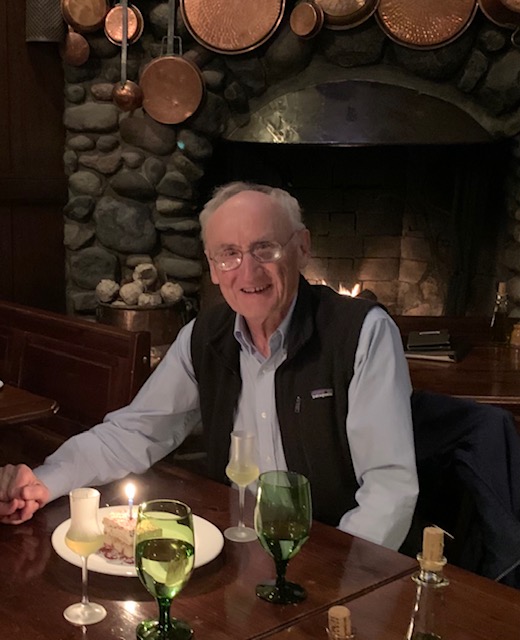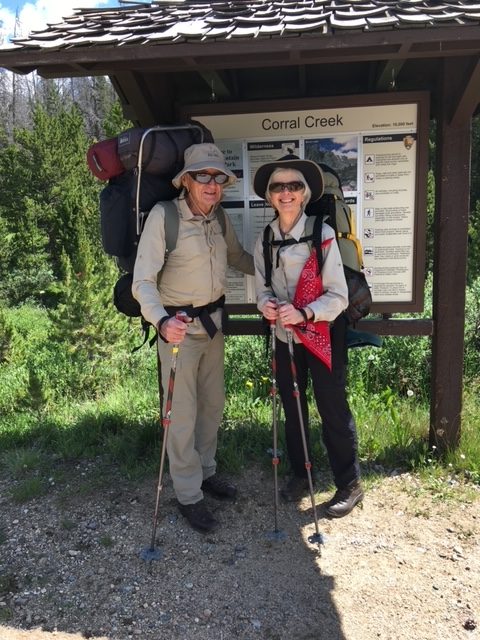Our Stories: Hans Jordan
by Wynn Montgomery
You are not likely to meet Hans Jordan in a committee meeting. He is more of a hands-on kind of guy, and the ‘Ship needs more like him. He is a member of several Grounds Teams and will continue as co-leader of one of the Sunday morning Hospitality Teams when we return to in-person services. He was a regular volunteer for the many moving tasks associated with entering and exiting our permanent buildings and our temporary space, and a frequent participant in the Prairie Dog Wars. Back when the sanctuary was used for social events and then had to be ready for Sunday services, Hans was always there to set up and stayed to help clean up.
Hans participates in other BVUUF activities, but always avoids the spotlight. In fact, he agreed to be interviewed for this article only because he thought that he might eventually be able to use it as his obituary. That reply is only one example of Hans’ dry, often self-effacing, wit. He has served one term as Board Secretary, and was an initial member of a Men’s Covenant Group, where his input was always thoughtful and thought-provoking. He is also a regular participant in a weekly men’s walking/hiking group where his knowledge of local trails is invaluable.
Hans was born in Germany at the start of WWII. He and his twin sister were the second and third of four children; he was the only boy. His father was an aeronautical engineer; his mother a teacher and, later, a housewife. Wartime Germany was the target of regular bombing raids, so Hans missed out on what was to be his first year of school.
After the war, Hans’ father (like many German scientists) was recruited to work in England at the Royal Aircraft Establishment. Housing was scarce, so the Jordans shared a large manor house in the English countryside with four other German scientists’ families. Hans’ formal schooling began in a British elementary school and continued through the first part of a British Grammar School until his father was recruited by the Glenn L Martin Company – now Lockheed-Martin. The family settled outside of Baltimore, where Hans attended high school and then entered Johns Hopkins University where he earned an A.B. degree in Physics, but not before signing on as an Ordinary Seaman on a Norwegian freighter for a trip along the East Coast and to Latin America, for adventure (and to help with tuition.)
Following college, Hans spent one year at the University of Munich, after his draft board agreed that it qualified as graduate school and thus deferment; learned to ski in the Alps; and then returned to the U.S. to work towards a PhD in physics from the University of Maryland. While working on his thesis he became distracted by getting married and fathering a daughter. He heeded a call from Germany’s nuclear research center in Karlsruhe to join the aerosol physics group there, working on breeder reactor accident analysis. That led to a stint of two weeks at the French nuclear research facility near Aix en Provence, and interactions with its equivalent in Holland. His second daughter was born there.
He then returned to the U.S., where he joined Battelle Memorial Institute, the contract research company headquartered in Columbus, Ohio. He spent 15 years there, doing what he describes as interesting and diverse work. During that period, he also earned a Master’s degree in Chemical Engineering from the Ohio State University, which is just across the street from BMI. Hans says that while he thought this degree “might come in handy,” he did it primarily “for fun” and because his employer paid for the fees and his time.
In 1990, Hans, now divorced, accepted a job bringing the safety requirements of operations at the Rocky Flats nuclear weapons plant up to U.S. Nuclear Regulatory Commission standards, which brought him to Boulder. When that job ended with the facility’s closure, Hans moved to New Mexico, where he worked at Los Alamos while living in Santa Fe.
He was living in New Mexico when he met his future partner, Joan Mulcahy, through an early internet match-making service. Joan was living in Buffalo, New York, at the time, and she and Hans soon arranged to meet in Denver. They discovered many common interests—hiking, camping, bicycling, music, and travel, among others. Joan soon decided to move to Colorado; Hans emphasizes that she insists that the decision was driven by her love of the Western lifestyle. Hans moved to Colorado also, working remotely. He and Joan soon bought a house together—the Lafayette home that they still share.
Hans and Joan discovered another mutual interest when they went searching for something “beyond ourselves,” something spiritual. Joan had been Catholic, and Hans had been raised in a Lutheran family that conducted its own “services” at home with readings from the Bible. Hans says that while living in England he accompanied his parents to the local Church of England, but his sole interest was the music provided by a string quartet. Hans and Joan found common religious ground in Unitarian Universalism and followed BVUUF from the Masonic Temple to Lafayette, where both remain integral parts of our congregation.
The love of music that brought Hans to an Anglican church began as a child in his musical family. He played violin with a sister on piano and his father on cello. While in high school, he played in a group that joined the fledgling Goucher College orchestra. He played in various student orchestras; while in college, he played in the orchestras at Johns Hopkins then at The University of Munich. While with Battelle, he was part of an amateur string quartet, and helped to form a similar group in Boulder in 1990 and played with it until he moved to New Mexico. Later, fellow BVUUFer Elisabeth Kern-Roos joined that same ensemble. Hans no longer plays his violin, but observes that music has been a major part of his life.
Like his volunteer work at the Fellowship, Hans’ hobbies are active in nature. He bikes and hikes regularly, and pre-Covid he and Joan took at least one long trip each year. Those adventures have included European bike trips, a driving tour of the South focusing on Civil Rights history, and a Yellowstone Forever sponsored week observing wolves in Yellowstone National Park in winter. Their latest big trip was in April of this year. They were lucky enough to win via lottery one of the 64 daily permits to “The Wave,” an isolated area on the Utah-Arizona border that offers spectacular sandstone rock formations. Of course, a seven-mile hike in heavy winds was required before they could enjoy the magnificent views. Even Hans and Joan may now need to rest a bit—unless something at the Fellowship has to be moved, mowed, or pruned.


